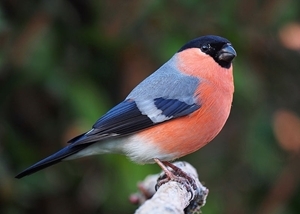The bullfinch
 The male bullfinch is a stunning bird, unmistakable with his vibrantly bright pinkish-red breast and cheeks, grey back, black cap and tail, and bright white rump, seen as he flies off into the thicket. The female lacks this colourful breast so is often harder to spot, however, should you see the male, keep looking as the female will surely be close by, as these birds stay together as a pair through the year.
The male bullfinch is a stunning bird, unmistakable with his vibrantly bright pinkish-red breast and cheeks, grey back, black cap and tail, and bright white rump, seen as he flies off into the thicket. The female lacks this colourful breast so is often harder to spot, however, should you see the male, keep looking as the female will surely be close by, as these birds stay together as a pair through the year.
Just the other day I spent a while watching a pair of bullfinch feeding on the seeds of wild clematis, or old man’s beard as many call this climber. I don’t recall ever seeing these secretive finches feeding on this plant before. They usually feed on the seeds or “keys” of the ash tree and also like to consume dock and honesty seed too, while I have also seen them feasting on the little black seeds of brassicas such as kale.
But it is their taste for the emerging buds of fruit trees that has quite literally been the downfall of this solidly built finch, as they were once considered a serious 'pest' of fruit crops.
During the 1950s and 60s many bullfinches were trapped and shot in an attempt to protect the orchards in Kent, Herefordshire and Worcestershire and students were employed to wander around the fruit farm banging drums, firing off blanks and generally disturbing the birds in an effort to move them on. Some commercial fruit farms are said to have killed up to a thousand bullfinch in just one year.
Bullfinch have always frequented gardens with plenty of cover in the form of trees and shrubs, but often they would go unseen to those who do not know their rather melancholy call, which reminds me of a gate hinge in need of a good squirt of oil.
However, lately individual birds have begun to use bird tables and seed hoppers, feeding on sunflower seeds in particular, making them far more noticeable. I believe this could well be a learned habit, copied from those in the “know”, similar to when blue tits learnt to take the tops off milk bottles to feed on the cream. An individual bullfinch adult will teach youngsters of the trick and even other adults may learnt what to do, so that it becomes common place in certain localities.
This sounds a little daft really, but it is only in the last few years that this behaviour has been recorded in this country, while it has been quite common on the continent for some time. I have a friend who tells me that he now has a regular stream of bullfinch coming to seed hoppers and that once one started to visit, others quickly followed.
However, I see bullfinch in my garden every day – but certainly not on the array of feeders I have distributed around the garden. They are obviously waiting for an experienced teacher to turn up and hold a class in “how to dine out at the fast food outlet”!
Peter Thompson
Advisory
Read more from Peter Thompson at the Fresh from the Field blog.
Image © Francis Franklin, used under the terms of the Creative Commons licence.

Download Peter Thompson's essential 26-page book, featuring beautiful photography and detailed profiles of Britain's wildlife
Download FREE >